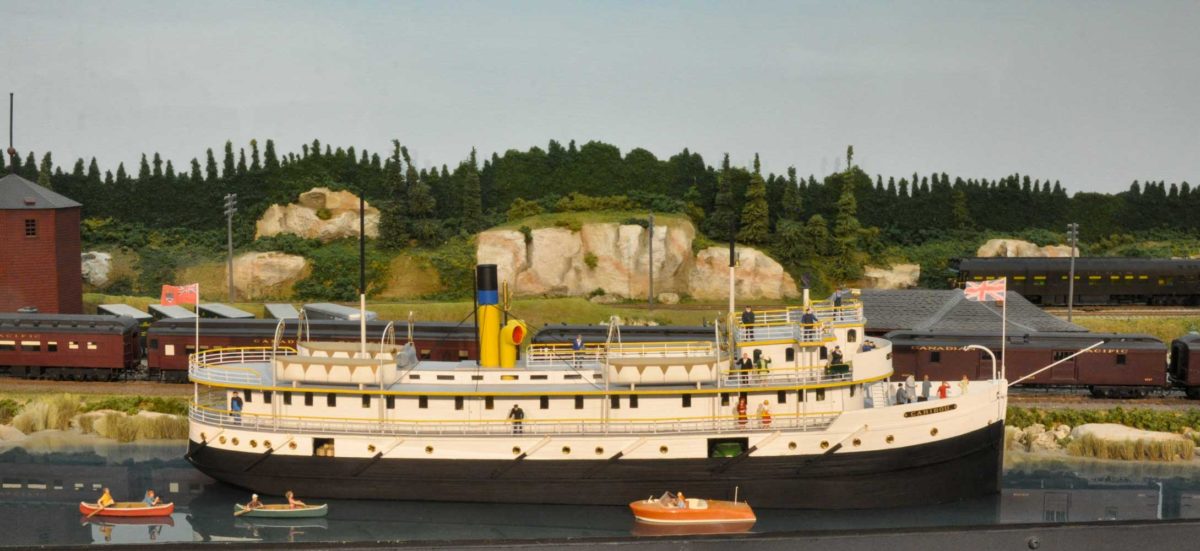by Keith Hopkin
SCARBOROUGH – COVID-19 began spreading across Canada around March 2020 or earlier. Hundreds of thousands of people lost their jobs as businesses closed down. The Canadian government asked its citizens to stay at home, stay six feet apart and wear masks to prevent the spread of the virus. So, day after day, Ann and I stayed at home with not much to do except watch TV and do odd jobs around the house. Boredom was setting in and the wife and I were getting on each other’s nerves.
So on June 29, I got this idea of constructing a model steamship to pass the time away and do something worthwhile as I sat at home. In the past I built a few model ships so building models was not entirely new to me.
Due to my fondness for the Manitoulin Island and the early steamships that came to the many ports around the Island, I decided to build the steamship named the Caribou. The Caribou was launched from her home port of Owen Sound in July 1904. The S.S. Caribou was a wooden hull ferry, 185 ft. long, 33 feet wide, 5,997 tons and carried a crew of 24. The Caribou serviced the “turkey trail” once a week from Owen Sound to Michipicoten and Pukaskwa. The ship’s meandering route carried Algoma Pioneers and all their worldly belongings to the many ports scattered along Georgian Bay, Manitoulin Island, the North Channel, Sault Ste. Marie, and up to Gargantua Harbour, Michipicoten, Michipicoten Island and as far as Pukaskwa Depot.
As one of the only means of transporting freight and goods to the majority of these tiny settlements along the shoreline, the S.S. Caribou and her sister ship, the S.S. Manitou, also conveyed tourists, food, poultry, cattle, horses, vehicles and barrels of fish for the Dominion and Booth fishing companies. Built to accommodate 40 passengers, the Caribou frequently carried up to 100 from Sault Ste. Marie to the booming mining camps of Michipicoten and Wawa.
The advent of affordable cars and the spread of paved highways further into northern Algoma meant the end of the more dramatic, but less efficient, water route. In 1947 the S.S. Caribou was purchased by M.J. Dacey and beached near Bell’s Point, east of Sault Ste. Marie, with dreams of becoming a possible dining and tourist operation. But instead the hull rotted and the ship was dismantled.
The S.S. Caribou had faithfully served the people of the Manitoulin Island and along the North Shore for over 42 years.
Steamship models like the Caribou cannot be bought commercially. If I wanted to have model ships on my layout, I would have to build them myself. I chose HO (railroad model) scale (1/87th size) for my models since I have an HO scale CPR-themed model railway and my model would have to be to the same scale as my layout to look right.

Since the model of the Caribou must have a flat bottom to be able to sit on my flat harbour, I had to build what they call a “water line” model. In other words, the model would have to have a flat bottom.
Since there are no drawings available (that I know of) for reference to build my model, I provided my son Jeremy with a straight on horizontal photo of the Caribou (courtesy of Buck Longhurst) and he took this photo and with his computer skills he made it to HO scale and with the result the model is 20 inches long. I printed off this photo and used it as my template to construct my model. The photocopies of this HO-adjusted photo are my blueprints to construct almost every detail of the ship.
The main bottom portion of the hull is made from a pine board that is sawed, sanded and shaped to the desired size. The top portion of the hull, the walls of the cabins, the floor and the roof are all made of various thicknesses of cardboard that have scale 1” x 6” stripwood glued to the cardboard sides. Each window opening is cut to size with an Exacto blade and sanded to the correct shape. The lifeboats are sawed, cut and sanded from blocks of pine to the desired shape. The brass portholes, the anchor and the brass railings on the main deck, upper deck and the wheelhouse roof are bought commercially from Cast Your Anchor. The smokestack, stack wires, whistle, steam pipe, lifeboat davits, flagpoles and other brass piping and wires are bought from hobby stores and made into various objects. The two tall masts are made from 3mm dowels. I used various acrylic paint colours to paint my model with. My son Jeremy produced the Caribou lettering that you see on my model including the Canadian flags on the bow and stern.
I have about 14 photos in my possession of the Caribou taken over the 42-year period that she sailed on the Great Lakes. I chose to paint my model in the colours after the merger of the Owen Sound Transportation Company and the Dominion Transportation Company with a black hull up to the freight rail, upper works white with fancy name boards and the stack buff, then a narrow band of blue and a black smoke band on top. My model closely represents that period with a bit of modeler’s licence thrown in.
• • •
Keith Hopkin, originally from Spring Bay, has had a decades-long passion for all things railway and North Channel steamship and has created several model ships based on those vessels that would have plied Island waters over the years.